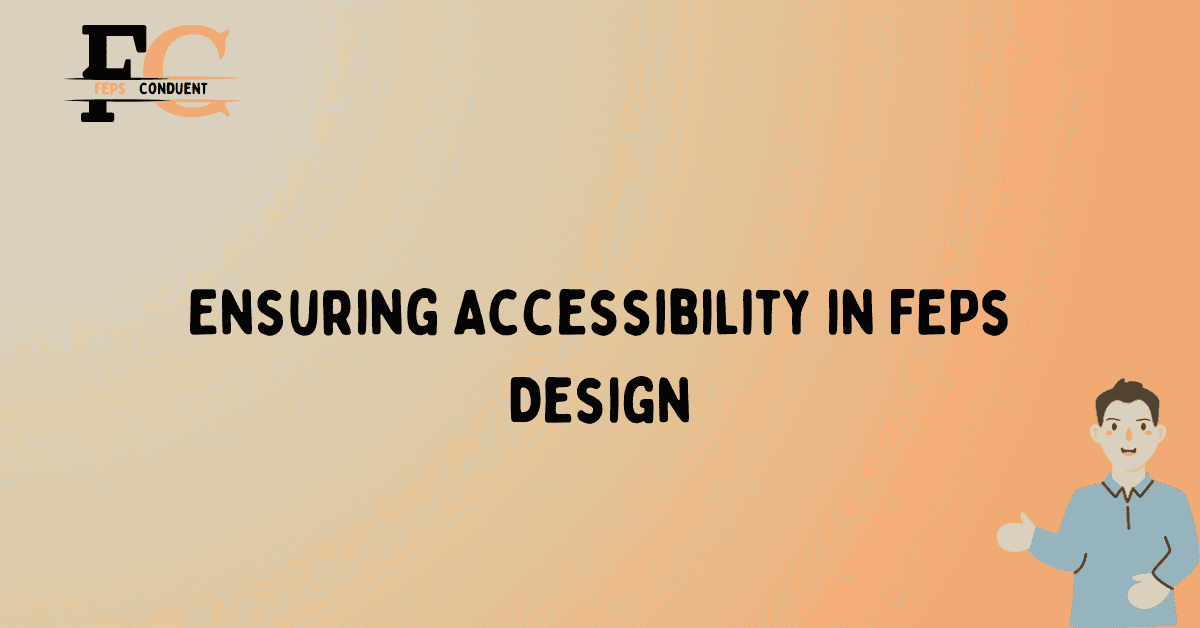Ensuring Accessibility in FEPs Design

Ensuring accessibility is a crucial aspect of designing Front-End Performance (FEPs). In today’s digital world, where websites and applications are accessed by people with diverse abilities and needs, it is essential to create FEPs that are inclusive and user-friendly for everyone.
Accessibility in FEP design involves making sure that the content and functionality of a website or application can be easily accessed and used by individuals with disabilities. This includes considering factors such as visual impairments, hearing impairments, motor impairments, and cognitive impairments.
Importance of Accessibility in Front-End Performance (FEP) Design
Creating a front-end design that prioritizes accessibility is paramount in ensuring a positive user experience for all individuals. Accessibility in Front-End Performance (FEP) design goes beyond just aesthetics; it encompasses the usability of a website or application for people of all abilities. By implementing accessible design principles, developers can make their products usable for individuals with various disabilities, creating a more inclusive digital environment.
Ensuring Inclusivity for All Users
One of the primary reasons why accessibility is crucial in Front-End Performance (FEP) design is to ensure inclusivity for all users. In today’s digital world, websites and applications are accessed by individuals with diverse abilities and needs. By creating FEPs that are inclusive and user-friendly, we can provide equal access to information and services for everyone.
Catering to Visual Impairments
Accessibility in FEP design involves considering visual impairments. This includes making sure that individuals with visual disabilities can easily access and understand the content and functionality of a website or application. By incorporating descriptive alternative text for images and using appropriate color contrast, we can enhance the usability for visually impaired users.
Addressing Hearing Impairments
Hearing impairments also need to be taken into account when designing accessible FEPs. It is important to provide alternative ways of accessing information, such as captions or transcripts for videos and audio content. By doing so, individuals with hearing disabilities can fully engage with the content and functionality of a website or application.
Accommodating Motor Impairments
Motor impairments can greatly impact the ability to navigate and interact with websites and applications. Accessibility in FEP design involves implementing features that accommodate motor impairments, such as providing keyboard shortcuts, properly labeled form fields, and ensuring that clickable elements are easily selectable. This ensures that individuals with motor disabilities can navigate and use FEPs efficiently.
Considerations for Cognitive Impairments
Cognitive impairments should also be considered when designing accessible FEPs. This involves creating clear and concise content, using simple and intuitive navigation, and avoiding distracting or overwhelming design elements. By making FEPs user-friendly for individuals with cognitive disabilities, we can enhance their overall browsing experience.
The Role of HTML Tags and Formatting
HTML tags like h3, h4, and bold formatting play a crucial role in organizing and presenting the content in an accessible manner. These tags help structure the information, making it easier for individuals using assistive technologies to navigate and understand the content. It is important to avoid using h1 or heading terms excessively, as it may confuse screen readers or other assistive technologies.
FAQs
What is the importance of ensuring accessibility in FEPs design?
Ensuring accessibility in FEPs (Front-End Performance) design is crucial because it allows people with disabilities to access and use websites or applications effectively. It ensures that individuals who are visually impaired, hearing impaired, or have mobility impairments can navigate and interact with digital content without any barriers.
How can accessibility be incorporated into FEPs design?
Accessibility can be incorporated into FEPs design by following web standards and best practices, such as using semantic HTML, providing alternative text for images, using proper color contrast, and ensuring keyboard navigation compatibility. It also involves conducting accessibility audits and user testing to identify and address any accessibility issues.
What are the benefits of incorporating accessibility in FEPs design?
Incorporating accessibility in FEPs design brings several benefits. It allows a wider range of users to access and engage with digital content, increasing the reach and usability of websites or applications. It also helps businesses comply with accessibility regulations and avoid legal issues. Additionally, accessible designs often improve overall user experience and can lead to increased customer satisfaction and loyalty.
Are there any specific guidelines or standards for ensuring accessibility in FEPs design?
Yes, there are several guidelines and standards that define best practices for ensuring accessibility in FEPs design. The Web Content Accessibility Guidelines (WCAG) provide a comprehensive set of guidelines for making web content accessible to people with disabilities. The WCAG covers various aspects, including perceivability, operability, understandability, and robustness.
What are some common accessibility barriers in FEPs design?
Common accessibility barriers in FEPs design include using non-semantic HTML, lack of alternative text for images, inaccessible forms or input fields, inadequate color contrast, and reliance on mouse-only interactions. These barriers can exclude individuals with disabilities from accessing and using websites or applications effectively.
How can businesses ensure ongoing accessibility in FEPs design?
Businesses can ensure ongoing accessibility in FEPs design by establishing accessibility guidelines and policies, providing training to developers and designers, and conducting regular accessibility audits and evaluations. It is also important to involve users with disabilities in the design and testing process to gather feedback and make necessary improvements.
Conclusion
Ensuring accessibility in Front-End Performance (FEP) design is essential to create user-friendly experiences for individuals with disabilities. By considering factors such as visual impairments, hearing impairments, motor impairments, and cognitive impairments, we can design FEPs that are inclusive and cater to the diverse needs of users. Incorporating appropriate HTML tags and formatting helps in structuring the content and making it easily accessible. Ultimately, accessibility in FEP design is about providing equal access and usability to all individuals, regardless of their abilities.






